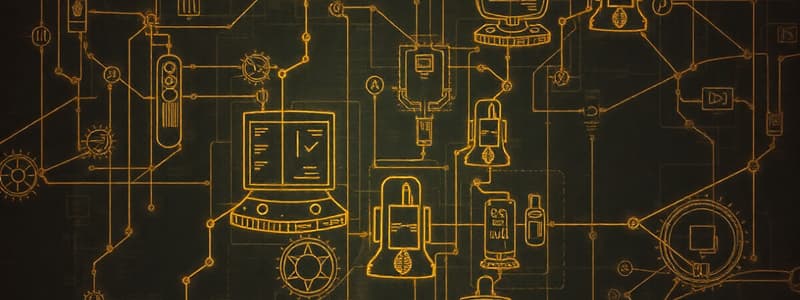Podcast
Questions and Answers
What is the main component used in the fifth generation of computers?
What is the main component used in the fifth generation of computers?
- Transistor
- Microprocessor
- Integrated Circuit (IC)
- ULSI (Ultra-Large Scale Integration) (correct)
Which programming languages are associated with the fifth generation of computers?
Which programming languages are associated with the fifth generation of computers?
- C, C++, and Java
- COBOL and FORTRAN
- High-level programming languages and AI-based languages (correct)
- Machine language and Assembly language
What significant technological advancement is associated with the fifth generation of computers?
What significant technological advancement is associated with the fifth generation of computers?
- Introduction of the microprocessor
- Use of punch cards for memory
- Development of artificial intelligence (correct)
- Implementation of magnetic tape storage
Which of the following describes the memory evolution from the first generation to the fifth generation?
Which of the following describes the memory evolution from the first generation to the fifth generation?
What is a notable characteristic of the fourth and fifth generations of computers compared to the earlier generations?
What is a notable characteristic of the fourth and fifth generations of computers compared to the earlier generations?
How is data best defined?
How is data best defined?
Which memory types were prevalent in the second generation of computers?
Which memory types were prevalent in the second generation of computers?
What programming languages characterized the third generation of computers?
What programming languages characterized the third generation of computers?
Which statement about information is correct?
Which statement about information is correct?
What component replaced transistors in the third generation of computers?
What component replaced transistors in the third generation of computers?
Which computer was the first electronic computer?
Which computer was the first electronic computer?
What advancements in technology characterize the fourth generation of computers?
What advancements in technology characterize the fourth generation of computers?
What ability allows a computer to work continuously without tire or error?
What ability allows a computer to work continuously without tire or error?
Which characteristic of computers refers to their speed in processing data?
Which characteristic of computers refers to their speed in processing data?
Which of the following statements is true regarding the input in data processing?
Which of the following statements is true regarding the input in data processing?
What does GIGO stand for in the context of computer accuracy?
What does GIGO stand for in the context of computer accuracy?
What is the full form of COMPUTER based on the definitions provided?
What is the full form of COMPUTER based on the definitions provided?
What is a key disadvantage of computer capabilities depicted in the content?
What is a key disadvantage of computer capabilities depicted in the content?
In the context of data processing, what does output refer to?
In the context of data processing, what does output refer to?
Which term describes the ability of a computer to perform a variety of tasks?
Which term describes the ability of a computer to perform a variety of tasks?
Flashcards
Computer's function
Computer's function
A computer performs calculations and processes data at high speed.
Data Processing Steps
Data Processing Steps
Input, Processing, and Output are the three main stages of data processing.
Computer Input
Computer Input
The raw data or information that a computer receives.
Computer Output
Computer Output
Signup and view all the flashcards
Computer Characteristics: Speed
Computer Characteristics: Speed
Signup and view all the flashcards
Computer Characteristics: Accuracy
Computer Characteristics: Accuracy
Signup and view all the flashcards
Computer Characteristics; Versatility
Computer Characteristics; Versatility
Signup and view all the flashcards
Data Processing
Data Processing
Signup and view all the flashcards
Data
Data
Signup and view all the flashcards
Information
Information
Signup and view all the flashcards
First Generation Computers
First Generation Computers
Signup and view all the flashcards
Second Generation Computers
Second Generation Computers
Signup and view all the flashcards
Transistor
Transistor
Signup and view all the flashcards
Third Generation Computers
Third Generation Computers
Signup and view all the flashcards
Integrated Circuit (IC)
Integrated Circuit (IC)
Signup and view all the flashcards
Fourth Generation Computers
Fourth Generation Computers
Signup and view all the flashcards
Vacuum tube
Vacuum tube
Signup and view all the flashcards
Microprocessor (VLSI)
Microprocessor (VLSI)
Signup and view all the flashcards
ULSI (Ultra-Large Scale Integration)
ULSI (Ultra-Large Scale Integration)
Signup and view all the flashcards
Study Notes
Basic Computer Concepts
- A computer is a device for computation.
- Computers are electronic devices.
- Computers process data at high speeds.
- Computers store and retrieve data.
- Computers perform arithmetic operations.
- Data processing is the process of transforming data into information.
- Input devices capture data.
- Processing units manipulate data.
- Output devices output information.
- Storage devices store data and information.
Computer Generations
- First Generation (1942-1955): Vacuum tubes, punch cards, machine language. Key computers include ENIAC, EDVAC, and UNIVAC.
- Second Generation (1955-1964): Transistors (instead of vacuum tubes), magnetic tapes and disks, assembly language.
- Third Generation (1964-1975): Integrated circuits (ICs) replaced transistors, significant storage increase (RAM), development of languages like BASIC, COBOL, FORTRAN.
- Fourth Generation (1975-1989): Very Large Scale Integration (VLSI), use of microprocessors, development of programming languages (C, C++, Java etc.).
- Fifth Generation (1989-Present): Ultra-Large Scale Integration (ULSI), Artificial Intelligence, internet, multimedia, high-level languages.
Data and Information
- Data are raw facts.
- Information is processed data.
- Information is useful data.
- Data is transformed into information through processing.
- Data forms the basis for decisions and actions.
Studying That Suits You
Use AI to generate personalized quizzes and flashcards to suit your learning preferences.




